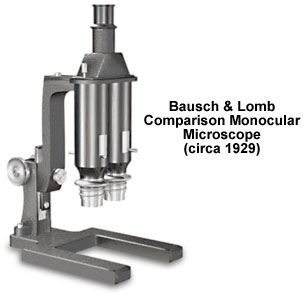Bausch & Lomb Comparison Monocular Microscope
In response to the multiple demands of forensic science and inspection microscopy for industrial quality control, Bausch & Lomb manufactured the comparison microscope in 1929. Based on the ingenious design by Albert S. Osborn, the Bausch & Lomb comparison microscope enables the comparison of two specimens juxtaposed in a single field, viewed by a single 10x Ramsden eyepiece.

The Bausch & Lomb comparison microscope is equipped with two 48-millimeter (2x) objectives, but higher power objectives, with magnifications ranging from 2.6x to 100x, are available as optional accessories. By recognizing that forensic applications often demand low-power, wide-field binocular microscopes, the Bausch & Lomb design engineers made their comparison microscope interchangeable with the KW binocular body and its paired eyepieces. Without having to move the specimen and reference materials or adjusting the illumination, the binocular body can be substituted for the comparison monocular body on the same sturdy black metal stand. The stereoscopic instrument provides three-dimensional relief and reveals overwriting, patching, erasures, folds, and crossed lines with startling distinctness that complements details revealed under the comparison microscope.
Forensic science applications include the examination of criminal evidence, such as fingerprints or bullets as well as signatures and other discrepancies associated with fraud and forgeries. Financial, insurance, legal, and law enforcement technical experts in the early twentieth century, comparing substances, surfaces, or colors, often used the comparison microscope. For dealers in antiquities and other collectibles, the Bausch & Lomb microscope would prove very useful for inspecting disputed or suspected documents and verifying historical documents, paper currency, artwork, gems, jewelry, finishes and patinas. The comparison microscope is also well adapted for quality control in industries such as textiles, paper, and paints, and for color matching, especially when the sample and reference materials are relatively small.
BACK TO TWENTIETH CENTURY BAUSCH & LOMB MICROSCOPES
BACK TO TWENTIETH CENTURY MICROSCOPES
